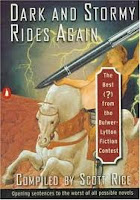Opening
Bibliographic Information:
Left
Behind (Novel #1) / by Tim LaHaye and Jerry B. Jenkins
ISBN-13: 978-1414334905/ Tyndale House
Publishers/
p. 496 / $10.19 (Amazon)
1995
Body of Content
Summary: A
non-religious Raymond Steele is an airplane pilot – married to a Christian
wife. Their children reflect the
attitudes of their parents, respectively – the daughter doubts, while the son
believes. When the Rapture happens – an
event where believing Christians are taken to heaven, while those left behind
must face the final events of history before the end of all things. Raymond faces a dilemma – finding out
first-hand about the Rapture, while flying a plane, as half the passengers
vanish. In the weeks that unfold, a
world leader (Nicolae Carparthia) tries to unite those people who remain – and
provide some stability to political and economic systems – and provide religious
answers to the questions arising from the ramifications of the Rapture. But as the story unfolds, Steele must decide
whose side he will join – and whose side he will resist.
Critique: The
novel is based off various biblical texts – such as the book of Revelation and
the book of Daniel – taking them as literal narratives for the eventuality of
future events in world history. Such
views – common within dispensationalist circles – offer a view, though, that
does not take the biblical texts within their historical contexts. To extrapolate the texts as future events
does not do the original texts justice – and leads to misunderstandings about
theology (cf. content) and hermeneutics (cf. methodology).
The issues are complicated and nuanced – but take one major
theme as an example. Dispensationalists
take the references to the Antichrist as a historical figure. The problem is that the biblical texts likely
do not support this conclusion. Several
times, the term carries an adjectival function, not a vocative title. One text highlights the possibility of
multiple antichrists (plural).
Another New Testament text refers to the antichrist
standing in the “temple of God” and declaring himself as God. Writers like LaHaye and Jenkins take this as
a reference to a future, evil leader standing in a physical temple. The problem is that such a Jewish temple complex
does not exist in Jerusalem – and in fact, one has not existed since AD
70. Thus, their theology requires the
existence of a reconstructed temple as a prerequisite for such a prophecy. The problem, though, is that the Greek manuscripts
– as that is the original language of the New Testament – contains two words
for the term “temple” – one refers to physical buildings (like the Temple in
the Old Jerusalem) and the other refers to the metaphorically understanding
(such as the temple of one’s own body).
The aforementioned problem text refers to the metaphorical term for
temple.
Overall, stronger support in the biblical texts disfavors
Lahaye’s “Antichrist” (person) in favor of “antichrist” (spirit of, in
general). The source of LaHaye and
Jenkins’ error is the wrong presupposition basis for the book genre of
Revelation – which leads to a snowball of hermeneutic mistakes – such as the
Rapture, one world government, mark of the beast, and seven-year tribulation
period. Suddenly, the biblical texts
become conspiracy novels like Left Behind
– instead of providing God’s view about theology and human activity
overall.
Teaser: Find out how an airplane pilot and an investigative
journalist team up to beat the Antichrist.
Information about the Author: The book’s authors worked
together to formulate the novel and the following (initial) 11 sequels. Jenkins is a writer by trade, while LaHaye
comes from writing and teaching backgrounds within theology. As such, Jenkins wrote most of the novel(s) –
with LaHaye’s framework and notes assisting in the creation of
manuscripts. Outside of the original 12
books in the Left Behind series – the
writing duo penned a 13th book – and 3 prequels – into the series
canon.
Both writers have written dozens of books before joining as a team – with Jenkins writing largely sports-related biographies, and LaHaye writing books on family counseling and eschatology. The Left Behind series hit markets in the mid-1990s through the Aughts and sold millions. In 2005, Amazon even ranked the duo as 9th on their author list of most books sold during the e-company’s first 10 years of business (Wikipedia, 2011).
Supplemental Material
Genre: Christian Fiction /
Adult Crossover / Apocalyptical
Curriculum Ties: English Literature – dystopian
views of future / Theology – dispensationalism, fundamentalism, eschatology
Booktalking Ideas: 1)
“It’s the end of the world – how did the whole thing get started?” 2) Have you ever
wondered what would happen if the book of Revelation became a literal
narrative?
Reading Level: This is an adult crossover
book – some interest by late teens (16-19) – particularly those from certain
religious (Christian fundamentalist, evangelical) backgrounds.
Challenge Issues and Defense: The book does not have
objectionable material (language, sex, etc.), though violence is
commonplace. Further, the novel contains
objectionable stances on various religious views and characterization of
non-Christians and Catholics. Ironically,
some Christians – from more liberal and moderate positions, or even
amillennialists from across various traditions – might take issue with the book
on theological grounds as opposed to content issues. Like other books, its heavy popularity is a
merit. But the book is an adult
crossover – which may mean placement in the adult section versus the YA section
– based on genre more than anything else.
Personal Reasons for Inclusion: I have
regrettably read too many books in this series. During my time at an accredited college and (later at) seminary, I realized this book (and series) offers
a flawed message.
Last Thoughts
References:
Wikipedia
(2011). Jerry B. Jenkins [Webpage]. Retrieved from
http://en.wikipedia.org/wiki/Jerry_B._Jenkins
Listening to (Music):
Artist – Evanescence / Album – “Evanescence (2011)”



